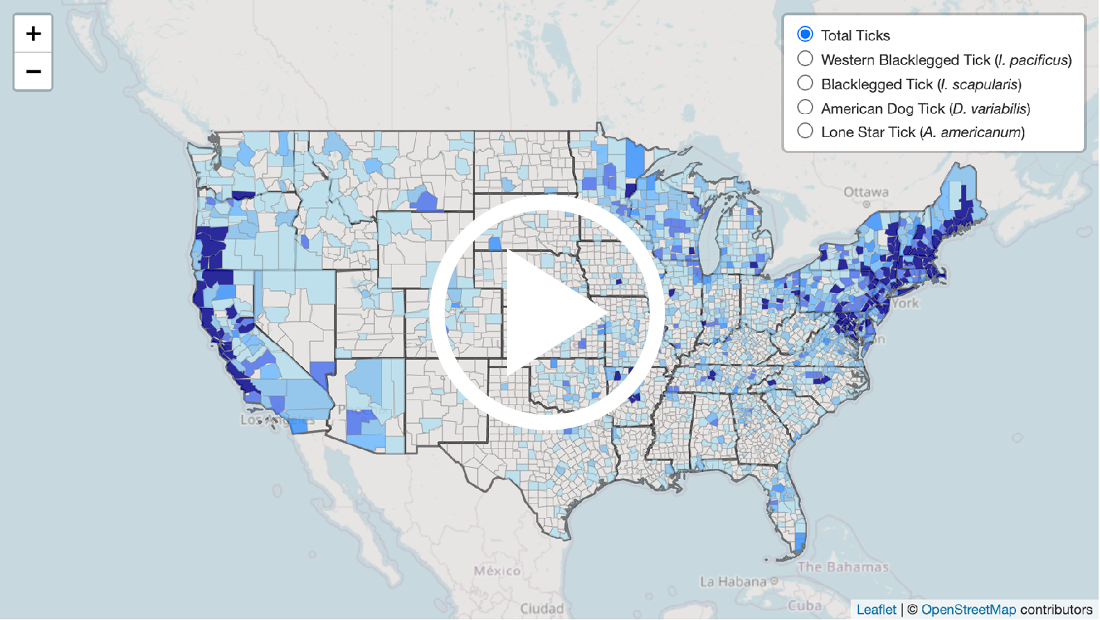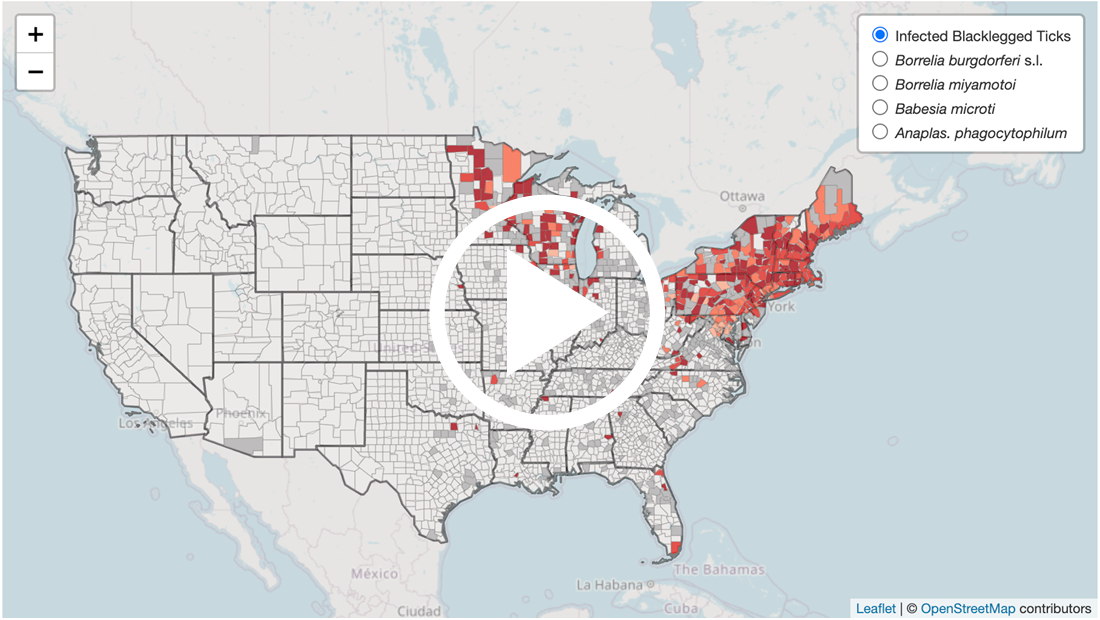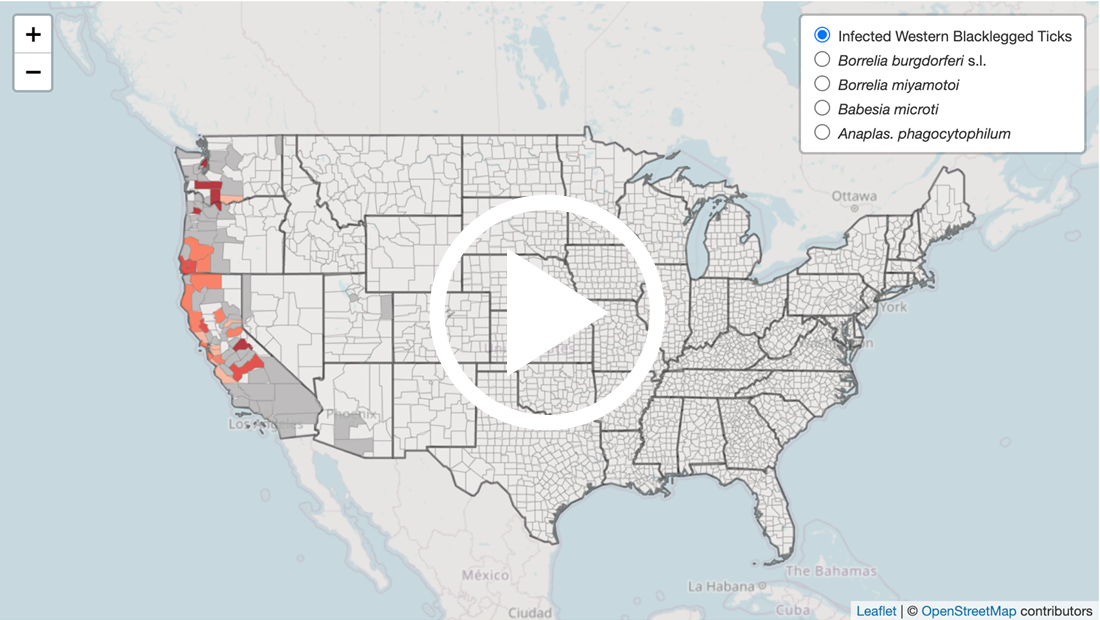Free Tick Testing Program
Bay Area Lyme Foundation’s Free Tick Testing Program has ended and is no longer accepting ticks for testing. We thank all of the Citizen Scientists who participated. It was a rousing success—we received and tested over 21,000 ticks representing every state. Click on the buttons below to jump right to those sections.
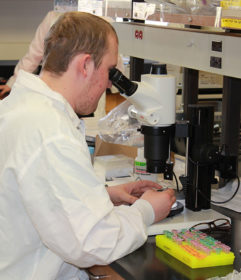
Research Project Overview
In February 2016, Bay Area Lyme Foundation became the first to offer free tick testing for residents of the United States. Testing was available through a partnership with Nate Nieto’s Lab at Northern Arizona University. With a citizen science focus, the crowd-sourced data was a vehicle for gaining a greater understanding of the geography of tick-borne diseases in the U.S.
During 2016 through 2018, ticks sent to the initiative were tested free of charge for four of the most common bacterial infections: Borrelia burgdorferi, which causes Lyme disease; Borrelia miyamotoi, which causes tick-borne relapsing fever; Anaplasma phagocytophilum, which causes human granulocytic anaplasmosis, and the protozoan pathogen, Babesia microti. These data were categorized, mapped, and recorded, as well as provided to the submitter.
The research project tested a massive sample of more than 21,000 ticks, collected from 49 U.S. states (all states except Alaska) and Puerto Rico. The program received a six-fold increase in tick submissions over initial estimates, representing unprecedented national coordination of a ‘citizen science’ effort and diagnostic investigation.
Research Findings
This citizen science program found ticks capable of carrying Lyme and other tick-borne diseases in 83 counties (in 24 states) where these ticks had not been previously recorded. The 24 states that contain counties with newly documented Ixodes scapularis (deer tick) or Ixodes pacificus (Western black-legged tick) populations are: Alabama, Arizona, Georgia, Illinois, Indiana, Iowa, Kansas, Kentucky, Louisiana, Michigan, Minnesota, Montana, Missouri, Nevada, North Carolina, Ohio, Oregon, South Carolina, Tennessee, Texas, Utah, Virginia, Washington, and Wisconsin. The map below illustrates this important finding.
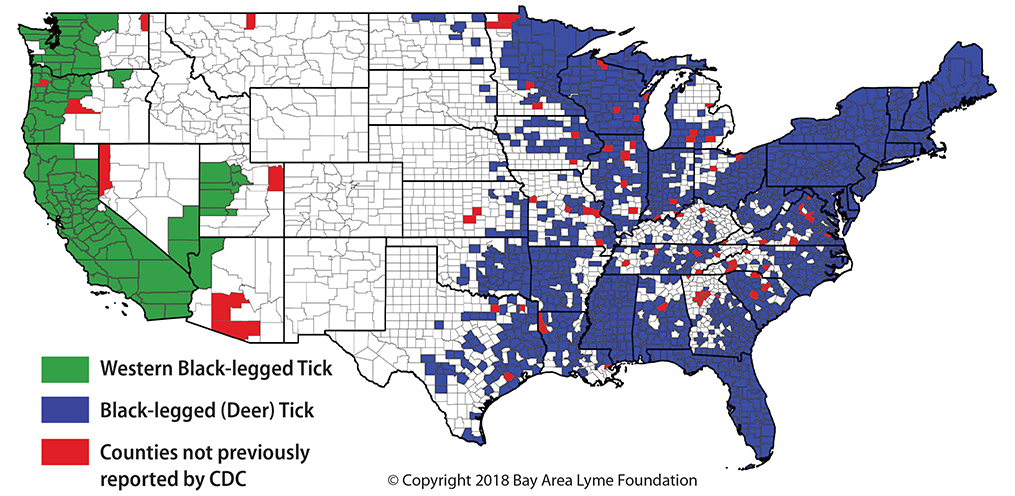
Other interesting research findings include:
- Anaplasma, Babesia, and Borrelia pathogens were found in all three of the most commonly encountered ticks collected—Ixodes, Amblyomma and Dermacentor species.
- All life stages of these three tick species, including some larvae, were found to be infected with both Borrelia burgdorferi and Borrelia miyamotoi.
- Several Amblyomma americanum, which is commonly known as the Lone Star tick and capable of carrying bacteria that cause disease in humans, were found in Northern California, the first known report of this tick in the state.
New data from the same study published in PLOS ONE (1/5/21) predicts and examines large-scale tick distributions on the Pacific Coast, highlighting areas of high risk of Lyme disease. This publication underscores the benefits of citizen science pointing out that this 2 years research would have required 30 years of data collection without the efforts of the individuals who sent ticks to Bay Area Lyme Foundation’s Free Tick Testing program. The study’s technique could allow for real-time distribution monitoring of ticks and other relevant species, an important consideration with emerging pathogens, changing land-use patterns, and climate change.
This program continued through 2019 with a Bay Area Lyme Foundation program grant to cover additional Bartonella testing, a disease-causing pathogen carried by ticks.
Bay Area Lyme Foundation’s Free Tick Testing Program was a citizen science success. Thank you to all who supported this effort by sending in ticks. Stay tuned for additional meaningful ecology results from the Free Tick Testing data collection.
While this program is no longer accepting ticks for testing, there are a number of other tick testing options available.
The full research publications can be found in PLOS ONE and International Journal of Health Geographics.
Citizen Science Maps
Which counties are home to ticks that can carry disease-causing pathogens, and what pathogens are they carrying? As part of Bay Area Lyme Foundation’s Free Tick Testing program, citizen-scientists from all over the US provided valuable insight into this pressing question.
Of the 20,429 ticks collected and sent to our researchers, 8,954 are Ixodes ticks capable of carrying the most common tick-borne diseases. These ticks were found throughout the U.S.
Check out the interactive maps below to explore their findings in your county as well as the counties where you visit and vacation. Please keep in mind that the results are limited by the ticks received from that area. For example, if an area is white, it means that no citizen scientists participated from that county, and there still could be risk there, especially if nearby counties are colorful. The research was conducted through a partnership between Bay Area Lyme Foundation, Northern Arizona University, Colorado State University and the Translational Genomics Research Institute (TGen). The data from this research has been published in PLOS ONE and mSPHERE.
Map #1: The U.S. counties where we found ticks capable of carrying disease
Citizen-scientists collected and provided the ticks evaluated in the study as part of Bay Area Lyme Foundation’s Free Tick Testing program (2016-2019). This map shows the distribution by county of the tick species collected, including western blacklegged tick, blacklegged tick, American dog tick, lone star tick. White counties indicate areas without tick submissions. Click here to use the interactive map.
Map #2: Where blacklegged ticks are carrying disease-causing bacteria
Blacklegged ticks (Ixodes scapularis), which citizen scientists sent to Bay Area Lyme Foundation’s Free Tick Testing Program (2016-2019), were tested for the presence of disease agents that cause Lyme disease (Borrelia burgdorferi sensu lato), tick-borne relapsing fever (Borrelia miyamotoi), babesiosis (Babesia microti), and anaplasmosis (Anaplasma phagocytophilum). Check out the map to see where we found ticks carrying these pathogens. Grey counties indicate where black-legged ticks were collected but pathogens were undetected. White counties indicate areas where no blacklegged ticks were collected. Click here to use the interactive map.
Map #3: Where western blacklegged ticks are carrying disease-causing bacteria
Western blacklegged ticks reside on the West coast of the U.S. As part of Bay Area Lyme Foundation’s Free Tick Testing Program (2016-2019), citizen-scientists sent Western blacklegged ticks to be tested for the presence of disease agents that cause Lyme disease (Borrelia burgdorferi sensu lato), tick-borne relapsing fever (Borrelia miyamotoi), babesiosis (Babesia microti), and anaplasmosis (Anaplasma phagocytophilum). Check out the map to see where we found ticks carrying these pathogens Grey counties indicate where western black-legged ticks were collected but pathogens were undetected. White counties indicate areas where no western blacklegged ticks were collected. Click here to use the interactive map.
